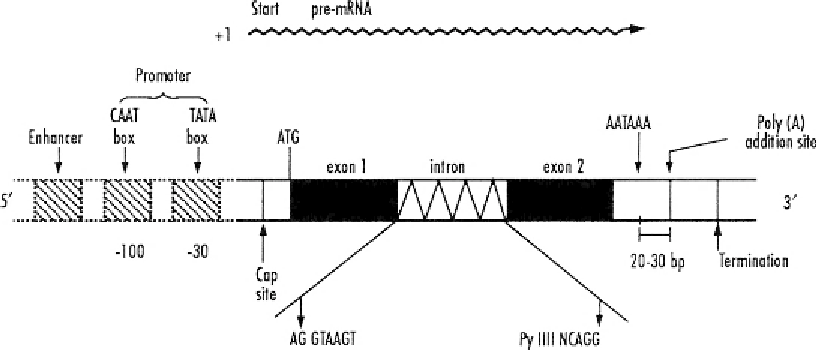Biology Reference
In-Depth Information
DNA, polymerize RNA, and proofread the developing transcript. RNA polymerase
II recognizes promoters and responds to regulatory signals (
Cramer et al. 2000
).
Transcription
is a complex, multistep process involving binding of RNA poly-
merase to the DNA, initiation, elongation, and production of a pre-mRNA tran-
script (
Hoffman et al. 1997, John and Workman 1998
). To initiate transcription
of a class II protein-coding gene, binding of RNA polymerase II must occur at
a specific point upstream of the DNA to be transcribed. This process usually
involves loading a protein called TFIID onto a promoter, followed by the recruit-
ment of a group of proteins called general transcription factors (GTFs). These
promoter-bound GTFs then recruit RNA polymerase II to form a preinitiation
complex.
The specific attachment sites of the preinitiation complex are called
promot-
ers
, and they are typically 20-200 nt long and are
≈
50 base pairs (bp) upstream
of the start site. Different eukaryotic promoter sequences are known but cer-
tain common, or consensus, patterns occur. For example, TATAAT and CAAT
are promoter sequences for protein-coding genes (
Figure 2.4
), and they often
are called the TATA and CAAT boxes. The location of the TATA sequence may
vary. Housekeeping genes (i.e., genes that are expressed in all cells to maintain
Figure 2.4
A more detailed view of a eukaryotic class II gene that codes for proteins. Promoters
often have CAAT and TATA boxes upstream from the start site. The left junction (splice donor, AG
GTAAGT) and right junction (splice acceptor, NCAGG) sequences of the intron are shown. Splice
sites are indicated by the arrow between AG and GT of the splice donor and between the two Gs of
the splice acceptor. The pre-mRNA synthesis is initiated at the
+
1 (start) site and proceeds in the 3
′
direction.

